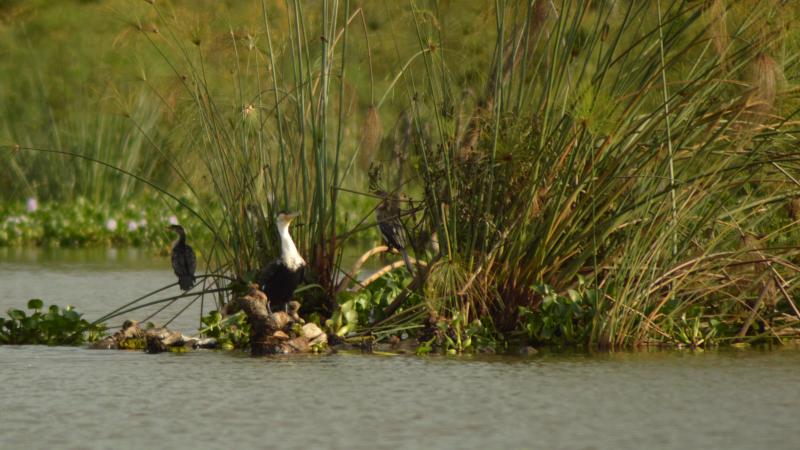
The animated movie Ice Age, released in 2002, features a motley crew of animals surviving the Paleolithic ice age. The vastly diverse characters—an accident-prone sloth, a condescending mammoth and a slightly dubious sabertooth tiger—come together to boost their chances of survival, and help each other in their journey. Before you brush this plot aside as a figment of imagination and creativity, did you know that there exist many examples of ‘friendship’ between animals belonging to different species? In a new study, researchers from the Indian Institute of Science (IISc), Bengaluru, have shed some light on what drives such unusual friendships.
The dynamics of animal society is intriguing. On the one hand, animals of the same species form ‘groups’, like a herd of elephants or a swarm of bees, to gather food, reproduce or rear the young ones. On the other hand, there are unusual ‘bonds’ between animals of different species—like the one between the Drongos and Babblers. Drongos follow Babblers to feed on insects that the Babblers flush out as they move. They cannot get this benefit by following other Drongos since they are a ‘sit and wait’ predator, perching and catching the incoming prey.
“Our understanding of animal sociality is almost entirely based on single species groups. Although mixed species groups are widely documented in different animal taxa, it is rarely studied with relation to single species groups”, says Dr. Hari Sridhar, a Research Scholar at IISc and an author of the study, in an interview with Research Matters. The study is published in the journal Philosophical Transactions of the Royal Society and supported by the Indian National Science Academy (INSA), Wissenschaftskolleg zu Berlin, and the DBT-IISc partnership program.
In the study, Dr. Hari Sridhar and Dr. Vishwesha Guttal have analysed previous studies on heterospecific social interactions—interactions between animals of different species. They have tried to understand how widespread the behaviour is regarding diversity in their taxa and the benefits that the relationship provides. They have also studied when and why an organism chooses to live in a mixed-species group and the factors that influence their choice.
Previously, scientists believed that groups with different species of animals (heterospecific social groups) and those with the same species (conspecific social groups) are two qualitatively different entities. They thought that heterospecific social groups were formed when animals of one species need benefits that cannot be obtained from individuals of their kind. However, recent studies have shown that this may not be true all the time. “A review of literature shows that most documented cases of heterospecific social groups are qualitatively similar to conspecific social groups, in terms of the mechanisms underlying social benefits”, says Dr. Sridhar.
The researchers say that the grouping occurs between species often for benefits very similar to what are obtained from conspecifics. For example, different species of fish that are similar in size and behaviour usually form a school to dilute the risk of getting caught. Though they are of different species, they manage to coexist since a larger group lowers the chance of becoming prey. There are about 200 such known cases of heterospecific sociality in different taxa, contexts and for different benefits, say the researchers, who have compared the similarities between them to throw some light on why they occur.
“In nature, the fates of different species are likely to be linked. When we think of a network in nature, we usually think about interactions between predators and prey, or a plant and a disperser. These interactions occur across trophic levels—the position of the organism in the food chain. However, in heterospecific social groups, these networks are found among species of the same trophic level that use the same resources. Their fates are linked as they depend on each other for social benefits”, remarks Dr. Sridhar, talking about the differences observed during the study.
The finding that there is a strong linkage between species makes the study ecologically significant. Certain group participants are called ‘nuclear species’, which are likely to provide benefits to other participants and is responsible for group formation and cohesion. If these species go extinct, many others will be affected since these nuclear species provide the most benefits. One such nuclear species is the small bird Fulvetta, which forms groups with other birds and warns them of predators. If the bird goes extinct, perhaps the group would not be the same as its role is hard to replace.
The study also highlights how changes in the environment could affect heterospecific social grouping. If a species of fish is introduced into a new environment, its survival depends on how well it fits in with a heterospecific group. In ecology, there is an understanding of how communities as a whole respond to fragmentation and disturbance. But, not how social systems—like mixed-species groups—respond to changes in the habitat and what happens to the gathering. Thus, the study also has implications for conserving biodiversity.
What lies in the future for the researchers? “Another postdoc in our lab, Anindita Das, is working on a mathematical model for this paper, which will hopefully, help further understand the choices made by an organism in picking a heterospecific social partner or a conspecific one”, signs off Dr. Sridhar.






